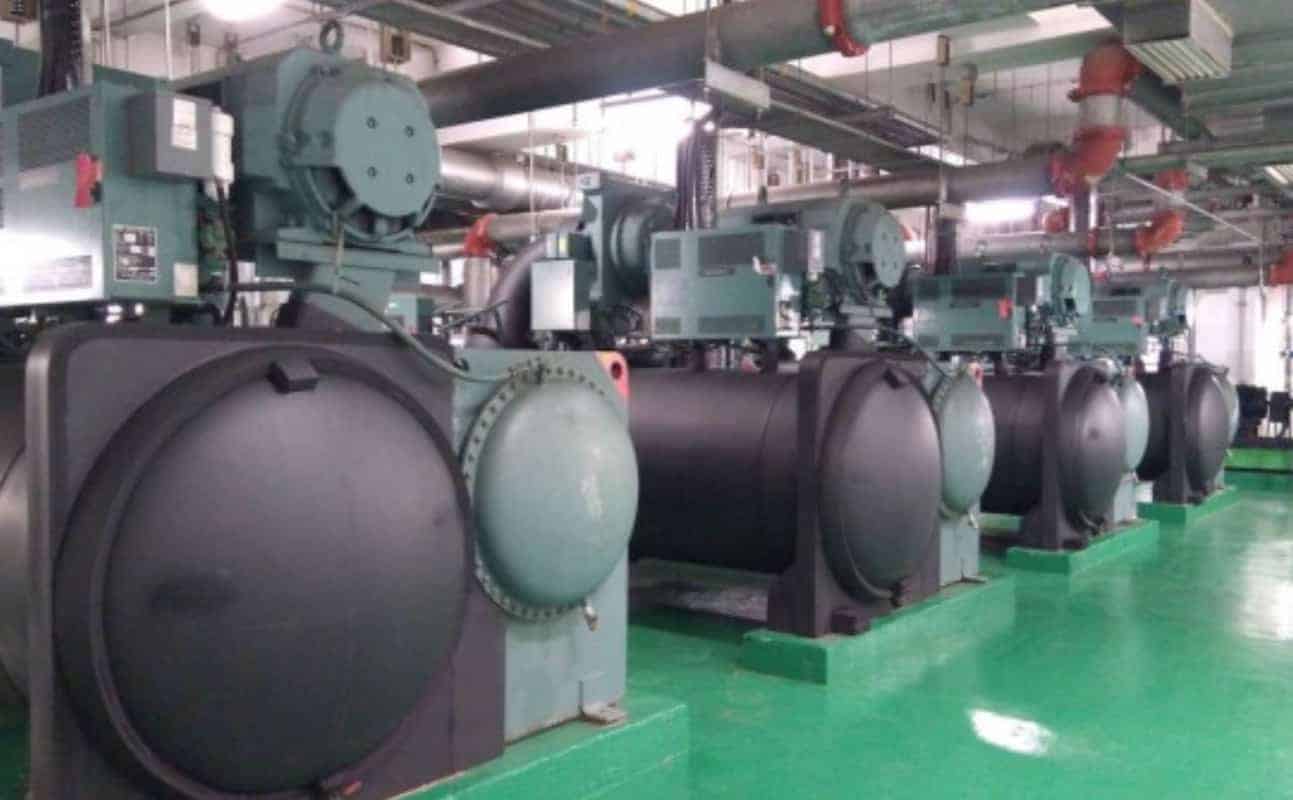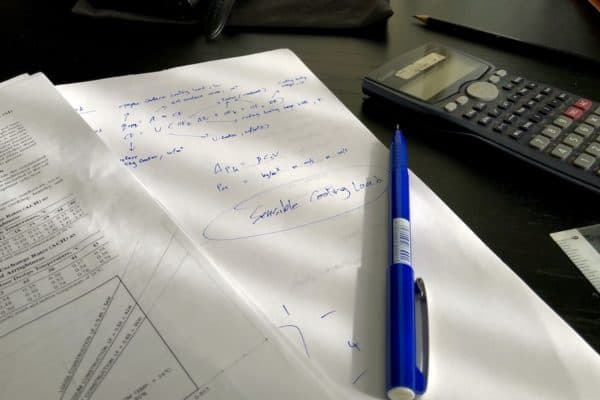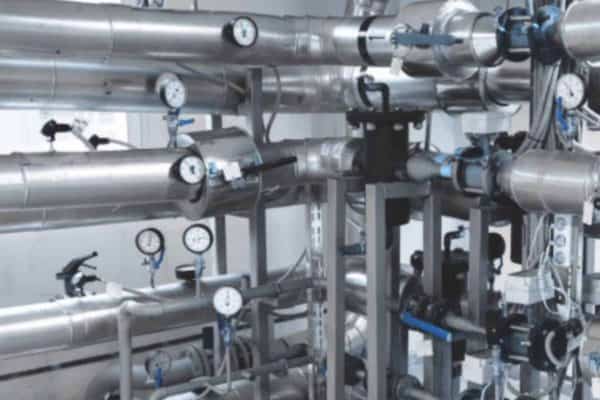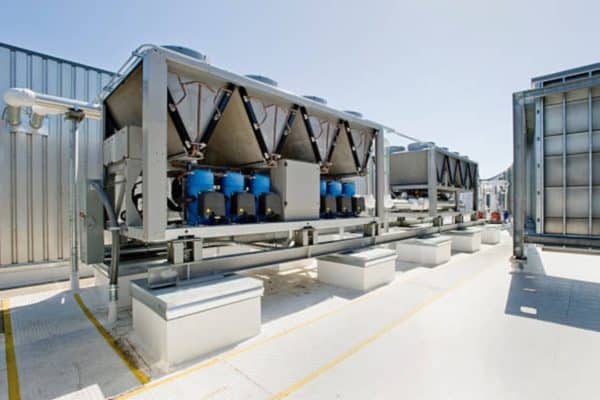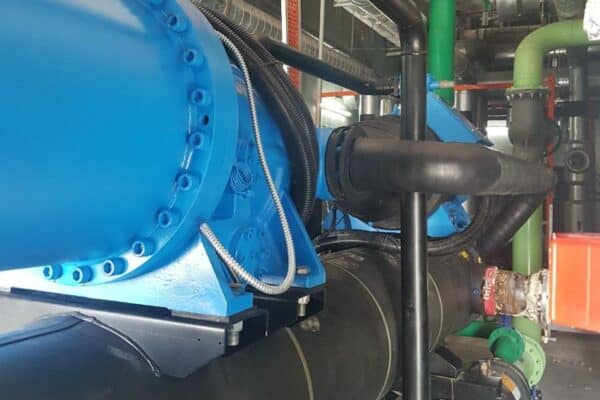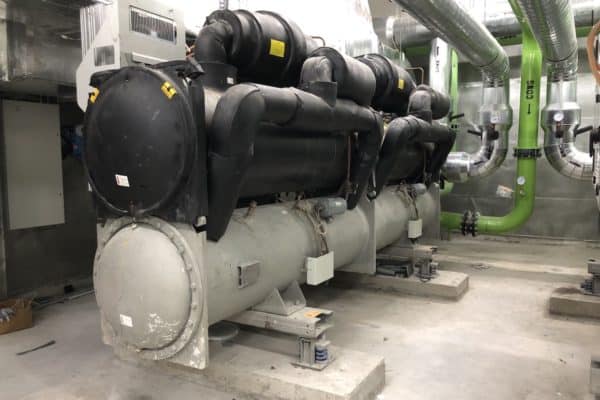How Chilled Water Temperature Affects Chiller Performance?
Chillers are designed to operate at a certain chilled water and condenser water temperature range. Increasing or decreasing either water temperatures will affect chiller performance. Many people thought that increasing the chilled water supply temperature improves the chiller efficiency but, it is more than that.
Standard chilled water temperature is 6.7°C (44°F) for supply and 12.2°C (54°F) for return. Standard condenser water temperature is 35°C (95°F) for the supply and 30°C (86°F) for the return based on outdoor 35°C (95°F) dry bulb and 27.8°C (82°F) wet bulb temperature.
Over time, chiller efficiency drops due to fouling, dirty AHU cooling coil and others. Hence, many people increase the chilled water supply temperature to accommodate the shortfall. However, they don’t realize that they’ve created another set of problems.
- How Increasing the Chilled Water Supply Temperature Affects Chiller Performance?
- Why Increasing the Chilled Water Supply Temperature is Causing Mold Problems?
- How Reducing Cooling Tower Fan Speed Affects Chiller Performance?
- Is It Possible to Reduce the Condenser Water Return Temperature to Increase Chiller Performance?
- How Reducing Condenser Water Pump Speed Affects Chiller Performance?
- How Dirty Condenser Tube Affect Chiller Performance?
- Low Delta T Syndrome
- How to Increase Chilled Water System Efficiency?
- Conclusion
How Increasing the Chilled Water Supply Temperature Affects Chiller Performance?
Chiller efficiency increased when the chilled water supply temperature increased because the refrigerant evaporating pressure increased.
To understand why, let’s take a look at a typical PH diagram that represents the refrigeration cycle as below:

PH diagrams are very useful for us to understand the refrigeration cycle happening inside a chiller and thus, get to know the relationship between the chiller performance and water temperature.
PH Diagram Explained
The above PH diagram curve is taken from the ASHRAE R134a PH diagram. I’ve simplified the diagram to help you understand it better.
A typical PH diagram has pressure on the y-axis and enthalpy on the x-axis. Gas Law stated that pressure is directly proportional to temperature. So, the y-axis also represents temperature.
Enthalpy is a property of the thermodynamic system but you interpret it simply as energy.
In the above PH diagram, P2 is the refrigerant condensing pressure while P1 is the refrigerant evaporating pressure. In between the start and end of the evaporation process is the refrigerating effect (RE).
Refrigerating effect (RE) is also known as the capacity of the chiller.
In between the start and end of the compression process (HC) is where external power is injected into the refrigeration system which is also known as the power input or power consumption of the chiller.
The alphabet “H” is used to represent enthalpy and “C” is the short form for the compressor. Hence, HC is the power input of the compressor.
The chilled water approach temperature of new high efficient chillers is below 1°C (1.8°F). Approach temperature is the temperature difference between the refrigerant and the water.
So, when the chilled water supply temperature is 6.7°C (44°F), the refrigerant evaporating temperature is around 6°C (42.8°F).
When the chilled water supply temperature increased to 10°C (50°F), the refrigerant evaporating temperature increased to around 9.4°C (49°F). Therefore, the refrigerant evaporating pressure also increased.
Below is the PH diagram with the increased evaporating pressure:
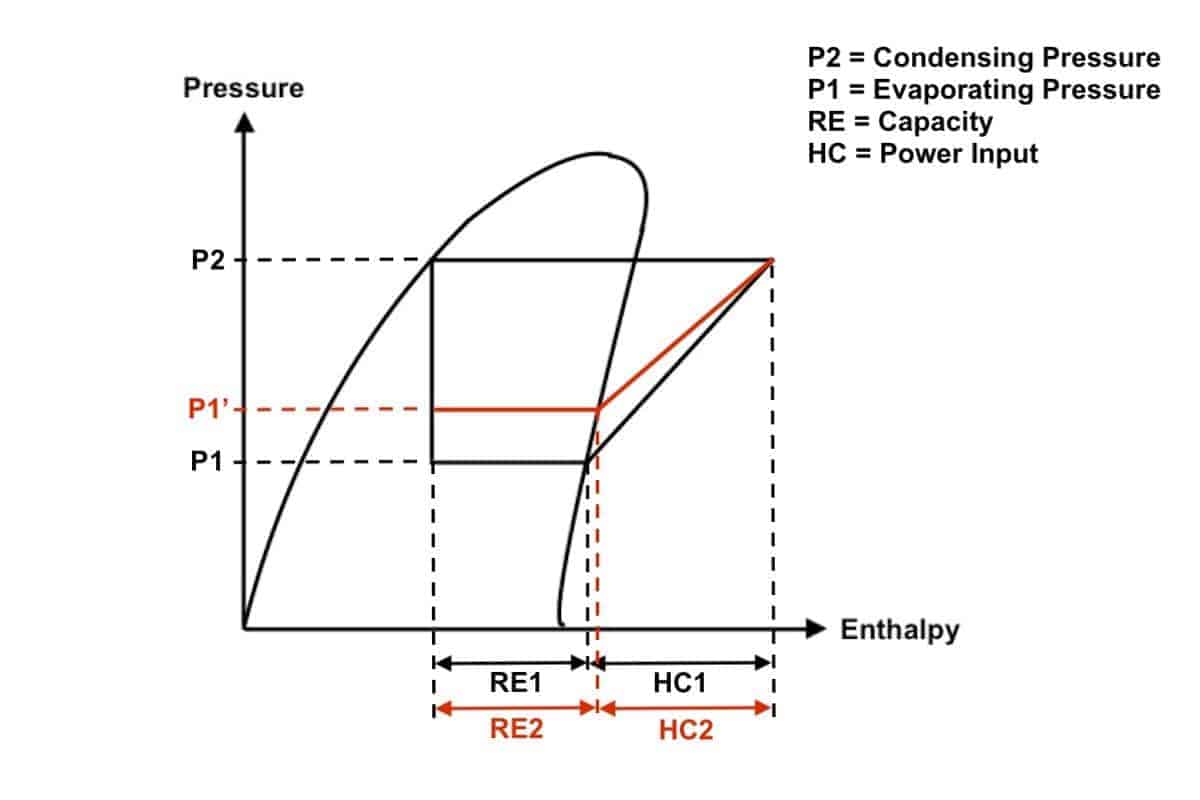
From the above PH diagram, the evaporating pressure (P1) rises to the new evaporating pressure (P1′). Notice that by increasing the evaporating pressure, RE2 is longer than RE1 and HC2 is shorter than HC1.
Since RE is the capacity of the chiller, a longer RE indicates that the capacity of the chiller increased. Also, since HC is the power input of the chiller, a shorter HC indicates that the power consumption of the chiller decreased.
Coefficient of performance (COP) is output divided by input. In this case, COP is the refrigerating effect (RE) divided by the compressor power input (HC).
COP1 = RE1 / HC1
COP2 = RE2 / HC2
So, COP2 > COP 1.
Therefore, increasing the chilled water supply temperature will increase the refrigerant evaporating pressure thereby increasing chiller efficiency and reducing chiller power consumption.
However, increasing the chilled water supply temperature can lead to high humidity problems and thus, mold and fungus growth problems.
Why Increasing the Chilled Water Supply Temperature is Causing Mold Problems?
Mold and fungus start to grow at 60% relative humidity (RH). So, the indoor humidity level must maintain below RH 60%, preferably RH 50-55%.
To reduce the humidity level, the water vapor in the air must condense into liquid water and therefore, decreasing moisture content in the air.
In order for the water vapor to condense, it must be cooled to below its dew point temperature. Dew point temperature is a variable and it is depending on the dry bulb temperature, relative humidity and pressure which is a constant.
Dew point temperature can be determined using Psychrometric Chart or any online dew point calculator which is also derived from Psychrometric Chart.
Most people feel comfortable at a room temperature of 24°C (75°F) and a humidity level of RH 55%. So, most buildings maintain that level of temperature and humidity. At which, the dew point temperature is 14.4°C (58°F).
Air conditioners reduce the moisture in the air by circulating the air through their cooling coil where the air is contacted with the cold cooling coil fins and condensation occurs.
So, the indoor air must circulate through a cooling coil that has a surface temperature of below the dew point temperature which is 14.4°C (58°F) in order to reach below RH 55%.
When the cooling coil is above the dew point temperature, the air will not condense and the humidity level will not drop further.
Standard delta T of the chilled water system is 5.5°C (10°F). Delta T is the difference between the chilled water supply and return temperature.
If the chilled water supply temperature increased to 10°C (50°F), the chilled water return temperature is expected to be around 15.5°C (60°F) while the standard chilled water return temperature is 12.2°C (54°F).
The new chilled water return temperature which is at 15.5°C (60°F) is higher than the dew point temperature which is at 14.4°C (58°F). Hence, a portion of the cooling coil can’t condense the air and the dehumidification capability of the cooling coil decreased.
So, increasing the chilled water supply temperature can cause high humidity problems because the dehumidification capability of the air handling units decreased, especially in humid countries such as Malaysia and Singapore.
Furthermore, many buildings didn’t separate their floors into different thermal zones or the supply air is not balanced. Hence, some people may feel the room temperature is warm while some people may feel it is just right.
Hence, the people that feel the room temperature is warm may decrease the thermostat setting from 24°C (75°F) to 22°C (71.6°F). When the room temperature decreased to 22°C (71.6°F), the dew point temperature also decreased to 12.5°C (54.5°F).
Needless to say, the high chilled water supply and return temperature which is at 10°C (50°F) and 15.5°C (60°F) respectively, further decrease the dehumidification capability of the air handling unit, resulting in the indoor humidity level raises to RH 60% or even RH 65% and above.
Therefore, high chilled water supply temperature often is the root cause of long-term mold and fungus growth problems in commercial buildings.
Many people also reducing the cooling tower fan speed in an effort to save energy. However, they don’t realize that they may be causing a higher electricity cost.
On a side note, if you want to quickly learn about chilled water system, you can get my Chilled Water System (eBook). If you’re into design, you can enroll in my Chilled Water System Design Course where I teach you various design procedures with tons of examples.
Chilled Water System Design Course
Learn how to design a chilled water system with AHU/FCU selection, chiller sizing, cooling tower sizing, pump sizing, piping design, ductwork design and more.
How Reducing Cooling Tower Fan Speed Affects Chiller Performance?
When the cooling tower fan speed is reduced, the airflow is reduced and hence, the heat exchange between the ambient air and the condenser water is reduced. So, the condenser water return temperature increased.
Standard condenser water delta T is 5°C (9°F). If the condenser water return temperature increased from 30°C (86°F) to 33°C (91.4°F), the condenser water supply temperature increased from 35°C (95°F) to 38°C (100.4°F).
The condenser water approach temperature of new chillers is below 4°C (7.2°F). Hence, when the condenser water supply temperature is 38°C (100.4°F), the refrigerant condensing temperature increased from 38.3°C (101°F) to around 41.7°C (107°F).
Since temperature is directly proportional to pressure, the increase in the refrigerant condensing temperature will result in an increase in the refrigerant condensing pressure.
Let’s bring up the PH diagram again to see how the higher condensing pressure affects chiller performance:

From the above PH diagram, the condensing pressure (P2) rises to the new condensing pressure (P2′). Notice that by increasing the condensing pressure, RE2 is shorter than RE1 and HC2 is longer than HC1.
Therefore, reducing cooling tower fan speed will increase the condenser water return temperature thereby decreasing chiller efficiency and increasing chiller power consumption.
So, if increasing the condenser water return temperature will decrease the efficiency of the chiller, isn’t it decreasing the condenser water return temperature will increase the efficiency of the chiller?
Is It Possible to Reduce the Condenser Water Return Temperature to Increase Chiller Performance?
Take a look at the below PH diagram with the decreased condensing pressure:

Decreasing the refrigerant condensing pressure has a similar effect as increasing the refrigerant evaporating pressure. Chiller efficiency will be increased and chiller power consumption will be decreased.
So, it is true that decreasing the condensing water return temperature will increase chiller efficiency.
However, the condenser water return temperature is depending on the ambient wet bulb temperature which is relatively high in humid countries.
Cooling towers use evaporative cooling for heat rejection. Thus, the higher the wet bulb temperature, the higher the condenser water return temperature.
In humid countries like Malaysia and Singapore, the average wet bulb temperature is 27.8°C (82°F). Theoretically, it is the lowest possible condenser water temperature.
However, there is energy loss during heat transfer. Hence, the cooling tower approach temperature is designed at below 2.8°C (5°F). Cooling tower approach temperature is the difference between the ambient wet bulb temperature and the condenser water return temperature.
Thus, the condenser water return temperature in humid countries is mostly around 29-30°C (84.2-86°F).
Relevant post: What is Chiller Approach?.
Since the standard condenser water return temperature is already at 30°C (86°F), it is almost impossible to decrease it further unless it is at night where the ambient wet bulb temperature can drop to around 25°C (77°F).
Therefore, decreasing the condenser water return temperature is not a good energy-saving solution in humid countries because the ambient wet bulb temperature is relatively high.
Furthermore, attempting to save energy by reducing the condenser water pump speed will also lead to low chiller efficiency because the condenser water return temperature is higher.
How Reducing Condenser Water Pump Speed Affects Chiller Performance?
Flow rate is inversely proportional to temperature. The lower the condenser water flow rate, the higher the condenser water return temperature.
When the condenser water return temperature is high, the refrigerant condensing temperature and pressure are increased.
Therefore, reducing condenser water pump speed will increase the condenser water return temperature thereby increasing chiller power consumption.
Besides, many people are not cleaning the chiller condenser tube regularly which is affecting chiller performance.
How Dirty Condenser Tube Affect Chiller Performance?
The chiller condenser tube gets dirty much more quickly than the evaporator tube due to the open loop condenser water piping system.
When the chiller condenser tube is dirty, the heat transfer is not efficient. Thus, the refrigerant condensing temperature is not effectively lowered by the condenser water, causing high refrigerant condensing temperature.
Therefore, not cleaning the chiller condenser tube regularly will increase the refrigerant condensing pressure thereby lowering chiller efficiency.
A very common problem in the chilled water system is low delta T syndrome. Low delta syndrome refers to the reduced difference between the chilled water supply and return temperature.
Low Delta T Syndrome
Low delta T is lead by low chilled water return temperature. The most common cause of low chilled water return temperature is dirty AHUs and FCUs cooling coil.
How Dirty Cooling Coils Affect Chiller Performance?
When a cooling coil is dirty, the heat transfer efficiency is reduced which means that less heat is absorbed by the chilled water. Hence, the chilled water temperature does not rise to the expected temperature which is 12.2°C (54°F).
If the chilled water return temperature decreased, the refrigerant evaporating temperature decreased and thus, the refrigerant evaporating pressure also decreased.
Therefore, not cleaning the air handling units and fan coil units cooling coil regularly will lead to low chilled water return temperature thereby increasing chiller power consumption.
Besides, low chilled water return temperature is also commonly caused by improper chilled water flow control. Many faulty chilled water valves are not being replaced but simply forced to open fully.
Relevant post: Air Handling Unit Basics: Components, Specifications & Types.
How Improper Chilled Water Flow Control Affects Chiller Performance?
An air handling unit or a fan coil unit controls its cooling power based on the cooling demand which is depending on the thermostat. If the cooling demand is high, it’ll allow more chilled water to flow into its cooling coil. Otherwise, it’ll reduce the chilled water flow.
When a chilled water valve is forced open fully all the time, the chiller mistakenly thought that the cooling demand is high. Hence, the chiller works hard to produce chilled water.
However, if the actual cooling demand is low, the chilled water going into the cooling coil at 6.7°C (44°F) will not come out at 12.2°C (54°F) but maybe around 9-10°C (48.2-50°F).
So, the delta T is low and the chilled water return temperature is low. Thus, the refrigerant evaporating temperature and pressure are decreased.
Therefore, not controlling the chilled water flow to AHUs and FCUs properly will lead to low chilled water return temperature thereby decreasing chiller efficiency.
There are so many things that can reduce chiller performance but, is there anything that we can do to increase the efficiency of the chilled water system?
How to Increase Chilled Water System Efficiency?
One way to increase chilled water system efficiency is to reduce the chilled water flow rate and increase the AHU and FCU cooling coil size.
Such a method is known as high delta T setup. I encourage you to check out my post on what is high delta T chilled water systems where explained the high delta T setup and the common problem using high delta T setup.
By increasing the difference between the chilled water supply and return temperature, the chilled water flow rate can be reduced thereby saving energy and cost on chilled water pumps.
Conclusion
Knowing how to read the PH diagram and Psychrometric Chart is extremely useful to understand how a chiller works fundamentally. Besides, it helps us to recognize that some of the common energy-saving practices may not work.
Let’s recall all conclusions made in this post:
- Increasing the chilled water supply temperature will increase the refrigerant evaporating pressure thereby increasing chiller efficiency and reducing chiller power consumption.
- High chilled water supply temperature often is the root cause of long-term mold and fungus growth problems in commercial buildings.
- Reducing cooling tower fan speed will increase the condenser water return temperature thereby decreasing chiller efficiency and increasing chiller power consumption.
- Decreasing the condenser water return temperature is not a good energy-saving solution in humid countries because the ambient wet bulb temperature is relatively high.
- Reducing condenser water pump speed will increase the condenser water return temperature thereby increasing chiller power consumption.
- Not cleaning the chiller condenser tube regularly will increase the refrigerant condensing pressure thereby lowering chiller efficiency.
- Not cleaning the air handling units and fan coil units cooling coil regularly will lead to low chilled water return temperature thereby increasing chiller power consumption.
- Not controlling the chilled water flow to AHUs and FCUs properly will lead to low chilled water return temperature thereby decreasing chiller efficiency.
- High delta T setup can increase chilled water system efficiency.
There you have it. The relationship between the chilled water temperature, condenser water temperature and chiller performance. I hope you learn something from this post.
More technical posts like this:
Once again, you can get my Chilled Water System (eBook) to quickly learn more about chilled water system. But, if you want to learn how to design a chilled water system from start to end, I encourage you check out my Chilled Water System Design Course.
Chilled Water System Design Course
Learn how to design a chilled water system with AHU/FCU selection, chiller sizing, cooling tower sizing, pump sizing, piping design, ductwork design and more.
If you have anything to add (or ask) about this topic, leave a comment down below!


